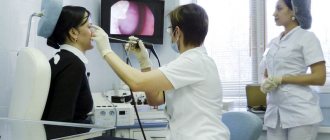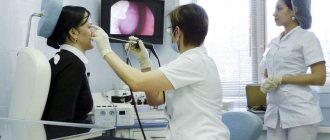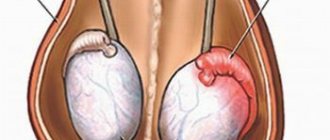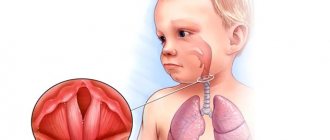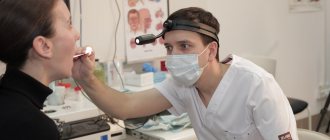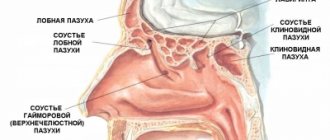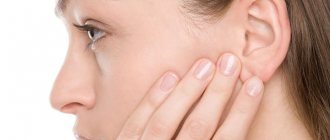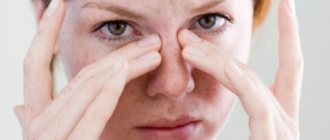Tracheitis can be acute or chronic. Acute develops and progresses quickly and responds well to treatment. With the right therapy, it is possible to completely get rid of the disease in about 2-3 weeks.
Chronic tracheitis has a sluggish and long course (in some patients throughout life), with exacerbations and remissions. There are two types:
- Atrophic - with this type of tracheitis, the mucous membrane becomes thinner. Crusts form on the surface of the trachea. The patient suffers from a dry cough.
- Hypertrophic - the mucous membrane of the trachea thickens. The patient has a cough with sputum.
Causes of tracheitis
The chain of causes of tracheal disease is quite easy to trace.
If tracheitis occurs against the background of acute viral respiratory diseases (ARVI), then the initial trigger can be considered insufficient effectiveness of the immune system. The length of the trachea in an adult is 10-13 cm and is located between the larynx and bronchi. The upper part of the trachea, connecting to the larynx, belongs to the upper respiratory system, and the lower part, which has branches into the bronchi, is already the lower respiratory system. With tracheitis, the inflammation process occurs in the upper part of the trachea. If the lower part of the trachea is affected, complications in the form of another disease - bronchitis - are possible.
Typically, tracheitis occurs against the background of other diseases of the respiratory system. If the problem is ignored, it can become chronic, which will bother the person for years or cause complications such as pulmonary obstruction, laryngeal stenosis (edema), severe bronchitis and pneumonia.
During epidemics, when the concentration of viruses and pathogens in the external environment goes off scale, the development of tracheitis is not uncommon. Attacking factors are infectious agents that enter the respiratory system from the outside and begin to actively act under the influence of external factors, such as cooling, other viral infections or immunodeficiency. Infection refers to viruses and bacterial flora that can easily infect the mucous membrane of the trachea without proper protection2.
In addition to viruses and bacteria, the causes of acute or chronic tracheitis are:
- Prolonged hypothermia of the body
- Prolonged exposure to cold or extremely dry air
- Inhalation of polluted air in hazardous industries
- Smoking
- Alcohol abuse
Let us separately consider another reason for the development of such a disease as tracheitis - artificial pulmonary ventilation (ALV). That is, physical damage to the trachea during intubation. After just a few hours of the procedure, dystrophic changes form in the trachea, which lead to global damage to the mucous membrane. After ventilation is stopped, the damaged trachea will remain more vulnerable to infectious agents for a long time3.
Complications
We have already mentioned some dangerous complications of tracheitis. Let's look at them in more detail:
- Development of bronchial tracheitis and pneumonia. A frequent complication of incorrect, untimely therapy and in patients with a weakened immune system. The differences between tracheitis and bronchitis are as follows: the patient’s general condition worsens, intoxication, shortness of breath and other signs of respiratory failure increase, and a creak appears in the lung after tracheitis. This complication requires immediate hospitalization of the patient in a hospital.
- False croup in children. Due to the anatomical narrowness of the glottis in a child, the spread of edema to the mucous membrane of the larynx leads to acute attacks of suffocation. Such a complication is a reason to immediately call an ambulance.
- Bronchial asthma is a severe complication of allergic tracheitis.
Symptoms of tracheitis
It is difficult for a person to determine tracheitis on his own; it is often assumed that there is a problem with the larynx, that is, laryngitis has developed. Usually this is the case, but against the background of laryngitis, it is easy to miss tracheitis of the throat. Therefore, a medical diagnosis is required.
General signs of tracheitis can easily be confused with signs of laryngitis; many of the symptoms are the same2:
- The main symptom of tracheitis in adults is hyperemia of the tracheal mucosa (saturation of blood vessels). The blood vessels dilate and swelling increases.
- A paroxysmal cough occurs, often at night. At the beginning of the disease, the cough is dry, later supplemented by mucopurulent sputum discharge with small blood clots.
- Pain after coughing attacks. The source of pain is either in the larynx or behind the sternum.
- Loss of voice and hoarseness.
- General weakness, malaise and fever.
Treatment
Inhalations for acute tracheitis help reduce cough.
Photo: alexander_safonov / freepik.com First of all, it is necessary to influence the cause of the disease. For example, with a bacterial form of tracheitis, the patient is prescribed antibiotics (azithromycin, amoxicillin, cephalexin, ceftriaxone). For viral diseases, meglumine acridone acetate, rimantadine, proteflazid)1 are used. To treat allergic tracheitis, antihistamines (desloratadine, clemastine, hifenadine) are used.
Is it possible to take expectorants and cough suppressants at the same time?
Lashkina Irina Aleksandrovna, otorhinolaryngologist-otosurgeon of the Federal Scientific and Clinical Center of the Federal Medical and Biological Agency of Russia:
“After a coughing attack, sputum that is difficult to separate appears, but this cannot be regarded as a wet cough.
To improve its discharge, it is best to take mucolytic and expectorant drugs. The main purpose of mucolytic drugs is to thin thick sputum, and the main purpose of expectorant drugs is to remove mucus from the respiratory tract. Sputum expectorants are available in several forms: tablets, powders, syrups, lozenges and solutions for inhalation. It is not recommended to take expectorants and antitussives at the same time, since antitussives block the cough reflex, interfering with the discharge of sputum. To select the correct medicine and diagnose a cough (wet or moist), you need to consult a specialist.” Symptomatic treatment is aimed at eliminating tracheal spasm, thinning sputum and reducing laryngeal edema¹. Recommended:
- drinking plenty of water;
- distracting procedures: warm compress for the throat with dimexide or alcohol, mustard plasters on the shin, hot foot baths (only in the absence of high temperature);
- inhalations with herbal decoctions and essential oils (in severe cases, inhalations with an antibiotic are allowed¹;
- expectorant mixtures based on marshmallow root, oregano, pine buds, coltsfoot, plantain.
Inhalations with boiling water are contraindicated, since too hot steam will increase reflex irritation of the respiratory tract and can cause burns. The water temperature for inhalation should not exceed 60 degrees, for children under 7 years old - 35-40 degrees.
Inhalations for acute tracheitis
Lashkina Irina Aleksandrovna, otorhinolaryngologist-otosurgeon of the Federal Scientific and Clinical Center of the Federal Medical and Biological Agency of Russia:
“Inhalations can help reduce the frequency and severity of coughing attacks.
To eliminate dry and wet cough, it is possible to use saline inhalations, as well as saline-based inhalation solutions, together with bronchodilators, expectorants or herbal medicine, antiseptic drugs or antibiotics. Inhalations can be done using a nebulizer (a device for aerosol therapy) or the steam method. Contraindications for inhalation are elevated body temperature (above 37.5 °C), purulent sputum, nosebleeds, severe forms of pulmonary and heart failure, arrhythmia, hypertension, and other pathologies of the cardiovascular system. Don't self-medicate! For the correct choice of medications and effective selection of therapy, consult a specialist.” With a dry cough, it is necessary to thin the mucus to improve its removal. For this purpose, drugs based on guaifenesin, ambroxol and bromhexine are used. If a dry cough has not yet entered the productive stage (when sputum is already beginning to disappear), causes severe discomfort, is difficult for the patient to tolerate and interferes with normal sleep, taking antitussive drugs is allowed. These drugs are divided into two groups:
- Centrally acting antitussives. They affect the cough center located in the medulla oblongata, reducing its function. For this purpose, butamirate, codeine, dionine, glaucine hydrochloride, and ephedrine are used.
- Peripheral antitussives. Drugs in this group, due to their mild analgesic effect on the mucous membranes of the respiratory system, reduce reflex stimulation of cough. This group includes medications based on acetylaminonitropropoxybenzene and tipepidine.
Important! Antitussive drugs are contraindicated for wet coughs, as they interfere with normal sputum discharge.
Acute tracheitis
The acute form of tracheitis occurs in parallel with acute diseases of the respiratory systems located above the trachea. That is, the disease occurs suddenly and does not last long, especially with complex treatment of all affected areas of the respiratory system.
Acute tracheitis occurs in primary and secondary forms. The primary form means that the disease arose on its own. The secondary form is that tracheitis was the result of another infectious disease. The first form is extremely rare.
The following types of infections can cause infectious tracheitis:
- Bacterial – staphylococci and streptococci (bacterial tracheitis);
- Viral – all types of ARVI (viral tracheitis);
- Fungal – aspergillus, actinomycetes and candida (candidal tracheitis);
- Viral-bacterial infection (viral-bacterial tracheitis).
Nutrition rules
The text is for informational purposes only. We strongly urge you not to use diets, resort to any therapeutic menus or fasting without medical supervision. We recommend reading: “Why you can’t go on a diet on your own.” A certain diet for tracheitis will also help speed up recovery. To help the body fight infection, it is important to increase the percentage of animal protein foods and reduce the amount of carbohydrates in the diet. On the basis of carbohydrates, a favorable environment is formed for the growth of various pathogenic microorganisms, which complicates any inflammatory process, including tracheitis.
Best materials of the month
- Coronaviruses: SARS-CoV-2 (COVID-19)
- Antibiotics for the prevention and treatment of COVID-19: how effective are they?
- The most common "office" diseases
- Does vodka kill coronavirus?
- How to stay alive on our roads?
Diet foods should be high in calories and fortified. Cooking food requires steaming or boiling. It is very important to drink a lot. The daily amount of fluid consumed should reach one and a half to two liters. Water, teas, compotes, soups, and juices can form such a volume of liquid. The most beneficial foods for this pathology would be to eat wheat crackers, soups with vegetable or low-fat meat broths, porridges, boiled fish and low-fat meats, low-fat dairy products, eggs, fresh vegetables and fruits. You can drink any juices, compotes, decoctions, fruit drinks, jelly, green tea. Decoctions of rosehip or chamomile will be especially useful for tracheitis.
Chronic tracheitis
The symptoms of chronic and acute tracheitis and the process of the disease itself are almost identical. The main difference between chronic tracheitis and acute is the long course of the disease. Symptoms of tracheitis either subside or flare up again during the next onslaught of ARVI. With an exacerbation of the chronic form of the disease, the cough is more severe, and pain in the chest area causes more discomfort.
As a rule, the chronic form develops against the background of untreated acute tracheitis as a result of problems with the immune system or exposure to adverse factors. But in rare cases, chronic tracheitis occurs locally, developing simultaneously with bronchitis in people exposed to smoking, alcohol, and liver, kidney and heart diseases.
The causative agent is still a viral, bacterial, fungal infection or, in rare cases, an allergic reaction.
In certain groups of people, the chronic form of tracheitis is more likely to develop. This is facilitated by 2:
- Smoking and drinking alcohol, especially during infectious tracheitis
- Reduced immunity or immunodeficiency, hereditary and acquired
- Ecology and hazardous place of work (constant inhalation of gases, dust, etc.)
- Liver, heart and kidney diseases
- Other chronic diseases of the respiratory system - sinusitis, sinusitis, rhinitis or laryngitis
Folk remedies
Effective folk remedies for tracheitis:
- Marshmallow root. Available in syrup form. The basis of the drug is plant mucilage. It softens the throat, eliminating pain and promoting mucosal restoration. A protective film is formed on the surface of the epithelium, which reduces the irritating effect during a coughing attack. Marshmallow root also contains substances that thin phlegm and promote its removal.
- Marshmallow root. Available in syrup form. The basis of the drug is plant mucilage. It softens the throat, eliminating pain and promoting mucosal restoration. A protective film is formed on the surface of the epithelium, which reduces the irritating effect during a coughing attack. Marshmallow root also contains substances that thin phlegm and promote its removal.
- Heat the milk, put a teaspoon of butter and half a teaspoon of soda into a cup, drink the mixture in small sips.
- Oak bark. The main therapeutic effect of the bark is associated with tannins (their concentration can reach 20%). They promote the desquamation of epithelium affected by microbial agents and the improvement of the mucous membrane.
Compresses stand apart in folk medicine. It makes sense to administer them when there is no fever, the cough has become productive, but night attacks torment the patient, that is, approximately starting from the fourth day of illness. The compress for tracheitis is applied for 20 minutes an hour before bedtime. Under no circumstances should you put a compress on your throat, so as not to catch the thyroid gland. Only on the chest.
Compress recipes:
- A tablespoon of honey and 3 drops of eucalyptus essential oil.
- A tablespoon of dry mustard, two teaspoons of honey, 20 ml of sunflower oil, 3 drops of fir oil.
- Boil two potatoes, mash, add a spoonful of sunflower oil.
Diagnosis of tracheitis
In addition to the standard history taking, external examination, assessment of respiratory function, initial examination of the throat and auscultation using a phonendoscope, there are laboratory and instrumental diagnostic methods, as well as additional studies that can lead the doctor to tracheitis4. It is on the basis of diagnosis that the causes of tracheitis and methods of its treatment are determined.
- General and biochemical blood test. The simplest test to distinguish between viral and bacterial infections (based on C-reactive protein and other indicators)
- X-ray or radiography. The most common and familiar way to check the chest. The picture can be taken in front or side projections. The image clearly shows the lungs and trachea. Thanks to x-rays, it becomes much easier to identify signs of tracheitis and distinguish it from bronchitis or pneumonia.
- Taking and examining smears. A standard procedure in which the doctor uses a sterile cotton swab to take a swab from the mouth. Next, the material is sent to the laboratory, where all the necessary studies are carried out, identifying the pathogen and its sensitivity to antibiotics.
- Laryngotracheoscopy. The endoscope comes into play. This study is the most informative. A special tube with a camera is inserted into the larynx and trachea, thereby the doctor can visually identify characteristic features, swelling, redness, etc. and possible causes of the disease (with a viral infection there are specific changes in the organ). If the study involves the bronchi, the procedure is called tracheobronchoscopy.
- Taking sputum for analysis. In this case, the sputum of a sick person is collected and sent for bacteriological examination (microbiological examination). This procedure is used for a more comprehensive diagnosis of chronic cough to exclude other bacterial diseases (tuberculosis).
- Pharyngoscopy. The standard method is for the doctor to examine the throat using a spatula. First of all, pharyngitis is diagnosed, which makes it clear about the possible development of tracheitis.
- Rhinoscopy. The procedure is an examination of the nasal cavity. For this, an optical device is used - a rhinoscope. Rhinitis is detected as a consequence of a respiratory infection, which means progression of tracheitis is possible.
- X-ray of the sinuses. X-ray, images of which will determine the presence of sinusitis or sinusitis if they are suspected. The progression of the disease may also affect the development of inflammation in the trachea.
- Allergy tests. In rare cases, tracheitis occurs due to an allergic reaction. Allergy tests allow you to determine which allergens your body responds to. Various substances are applied to the skin; if a reaction occurs in the form of redness, itching or swelling, then the allergen has been identified.
In addition to the help of a therapist and otolaryngologist (ENT), to determine the causes and make a diagnosis, consultations with doctors such as an allergist, pulmonologist and even a phthisiatrician may be required.
Prevention
What should be the prevention of tracheitis? All preventive measures are aimed at strengthening the immune system, as well as desensitization, that is, reducing the body’s sensitivity to the effects of allergens. To prevent inflammation of the trachea, it is recommended:
- treat diseases in a timely manner - eliminate dental caries, colds and exacerbations of chronic diseases in a timely manner;
- normalize nutrition - include vegetables and fruits high in vitamins in the diet;
- take vitamins and immunostimulants - in the spring-autumn period it is advisable to use “Aevit”, “Immunal”, “Ascovit”, etc.;
- give up bad habits - eating fatty foods, smoking, alcohol abuse.
If you are prone to allergies, you need to carefully monitor the cleanliness of your home, since dust, animal hair and polluted or dry air irritate the throat and, as a result, provoke the development of allergic tracheitis.
First signs
Usually tracheitis begins according to a similar scenario with acute respiratory infections. First, the patient has a runny nose and a dry cough. A person may complain of weakness, sore throat, pain in the head. Hyperthermia up to 38-39 degrees can last up to 3 days, but sometimes it may not increase at all or rise to subfebrile levels of 37.5-38.0.
In young children, when tracheitis begins to develop, wheezing that can be heard at a distance may occur in the morning. Such wheezing usually goes away after the patient has cleared his throat. Shortness of breath with tracheitis, as a rule, does not occur.
